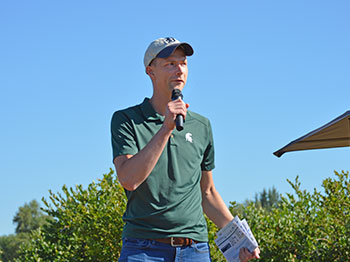Michigan Works to Capture Improved Flavor
Michigan growers have increased production of Duke, Draper and Calypso in recent years in hopes of capturing the improved flavor now favored by consumers, according to Josh Vander Weide, an assistant professor in the Department of Horticulture at Michigan State University. Now MSU researchers are researching whether delaying their harvest can improve flavor even more.
 |
Michigan State University Assistant Professor Josh Vander Weide at the OSU Blueberry Field Day provides a presentation on MSU research into whether delaying blueberry harvest improves flavor. |
In the research, harvest was delayed until certain percentages of ripeness were achieved. Typically, Vander Weide said in a presentation at the OSU Blueberry Field Day July 24 at the North Willamette Research and Extension Center in Aurora, Michigan growers begin harvest of fresh market blueberries at between twenty and forty percent ripeness.
“We wanted to try to push the fruit to hang on the plant until fifty percent ripeness, and then also seventy percent, just to see how the fruit would respond,” he said.
The researchers are using instruments to measure fruit size, firmness, sugar concentration, acid concentration, aroma concentration and other factors. And they have teamed with the MSU sensory science lab. “We really wanted to see if people can actually tell the difference,” he said.
Vander Weide noted that researchers expected to see a decline in fruit size corresponding to the length of time that a berry hangs on a plant. But that didn’t come to pass.
“Interestingly, we didn’t really see much of a change (between fruit that was harvested at ten percent ripeness and fruit harvested at seventy percent ripeness),” he said. “In some cases, we saw an increase in size.”
Another interesting development in the experiment is that a decline in firmness didn’t occur as the length of time the berries hung on the plants increased, or at least not to the degree researchers expected.
“In Duke, the first year we saw a decrease of about five percent, which is pretty marginal, and then, interestingly, we saw no change in Draper,” he said. The firmness in Calypso decreased the most, dropping about fifteen percent in firmness with the late harvest in the first year.
“And then, in the second year, we didn’t see any decline in fruit firmness for any of the cultivars,” he said.
In both years, he added, there was no decline in firmness in the fruit that was hanging two weeks longer than traditional harvest timing.
“So, based on firmness retention, we think that Duke and Draper are good candidates for delaying harvest.”
|
“So, based on firmness retention, we think that Duke and Draper are good candidates for delaying harvest,” Vander Weide said.
As for changes in sugar concentrations across the different maturity stages, researchers didn’t see an increase.
“That’s something you typically see with sugar in a lot of other fruit crops, but we were kind of intrigued to not see that with blueberries,” he said. “But, importantly, for all three cultivars, acidity really drops the longer the fruit hangs on the plant.”
Researchers saw about a fifty percent decrease in acidity in Duke and a thirty to forty percent drop in acidity for Calypso and Draper. “And that drives up that ratio between sweetness and acidity,” Vander Weide said. “And in our consumer sensory studies, we saw a nice correlation between the increase in that ration and how much people like the blueberries.
“So, to sum up those instrumental and sensory data, the longer that you wait to harvest, the more consumers like the fruit,” he said.
The recent push to plant new, better tasting varieties comes after decades of relying on older cultivars in Michigan, like Bluecrop and Elliott, Vander Weide said.
“And now that there’s this huge push from stakeholders and consumers looking for fruit with really great flavor, that’s a priority for growers to be producing cultivars that meet those requirements,” Vander Weide said. “And so, we are a little bit behind the game in Michigan, but over the last decade, we’ve been replacing a lot of these older varieties with newer ones that you’ve been producing here for quite some time now, like Duke, Draper and Calypso.”